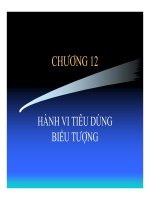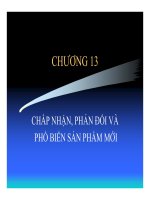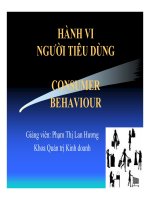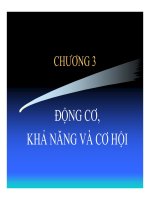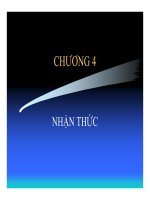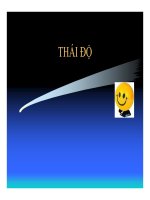Slide hành vi người tiêu dùng chương 3 learning anh memory
Bạn đang xem bản rút gọn của tài liệu. Xem và tải ngay bản đầy đủ của tài liệu tại đây (1.33 MB, 31 trang )
.c
om
Chapter 3
du
o
ng
th
an
co
ng
Learning and Memory
cu
u
CONSUMER
BEHAVIOR, 8e
Michael Solomon
CuuDuongThanCong.com
/>
.c
om
Learning Objectives
When you finish this chapter you should understand why:
ng
• It’s important for marketers to understand how
co
consumers learn about products and services.
th
an
• Conditioning results in learning.
• Learned associations can generalize to other things, and
ng
why this is important to marketers.
u
cu
conditioning.
du
o
• There is a difference between classical and instrumental
• We learn by observing others’ behavior.
Hoang Duc Binh, MBA, 2008
CuuDuongThanCong.com
3-2
/>
Learning Objectives (cont.)
ng
.c
om
• Memory systems work.
• The other products we associate with an individual
co
product influences how we will remember it.
th
an
• Products help us to retrieve memories from our past.
• Marketers measure our memories about products and
cu
u
du
o
ng
ads.
Hoang Duc Binh, MBA, 2008
CuuDuongThanCong.com
3-3
/>
.c
om
Learning is a Process
co
cu
u
du
o
ng
th
an
formed as a result of
a learning process,
sometimes with
painful results.
ng
• Our tastes are
Consumer Behavior
CuuDuongThanCong.com
/>
The Learning Process
.c
om
• Products as reminders of life
co
• Products + memory = brand
ng
experiences
th
• Learning: a relatively
an
equity/loyalty
du
o
ng
permanent change in behavior
caused by experience
u
• Incidental learning: casual,
cu
unintentional acquisition of
knowledge
Hoang Duc Binh, MBA, 2008
CuuDuongThanCong.com
3-5
/>
Behavioral Learning Theories
.c
om
• Behavioral learning theories: assume that learning takes
cu
u
du
o
ng
th
an
co
ng
place as the result of responses to external events.
Hoang Duc Binh, MBA, 2008
3-6
Figure 3.1
CuuDuongThanCong.com
/>
.c
om
Types of Behavioral Learning Theories
cu
u
du
o
ng
th
an
co
ng
Classical conditioning: a
stimulus that elicits a
response is paired with
another stimulus that
initially does not elicit a
response on its own.
Instrumental conditioning
(also, operant conditioning):
the individual learns to
perform behaviors that
produce positive outcomes
and to avoid those that yield
negative outcomes.
Hoang Duc Binh, MBA, 2008
CuuDuongThanCong.com
3-7
/>
Classical Conditioning
.c
om
Ivan Pavlov and his dogs
• Rang bell, then squirt dry meat
ng
powder into dogs’ mouths
co
• Repeated this until dogs salivated
an
when the bell rang
th
• Meat powder = unconditioned
du
o
ng
stimulus (UCS) because natural
reaction is drooling
• Bell = conditioned stimulus (UC)
cu
u
because dogs learned to drool
when bell rang
• Drooling = conditioned response
(CR)
Click to play
Pavlov’s dog game
Hoang Duc Binh, MBA, 2008
CuuDuongThanCong.com
3-8
/>
.c
om
Discussion Question
du
o
ng
th
an
co
crocodile was an exclusive
logo symbolizing casual
elegance. When it was
repeated on baby clothes
and other items, it lost its
cache and began to be
replaced by contenders such
as the Ralph Lauren Polo
Player.
ng
• In the 1980’s, the Lacoste
cu
u
• Can you thing of other logos
that have lost their prestige
due to repetition?
Consumer Behavior
CuuDuongThanCong.com
/>
.c
om
Marketing Applications of Repetition
Repetition increases learning
ng
th
an
co
ng
• More exposures = increased brand awareness
• When exposure decreases, extinction occurs
• Example: Izod crocodile on clothes
• However, too MUCH exposure leads to advertising wear
cu
u
du
o
out
Hoang Duc Binh, MBA, 2008
CuuDuongThanCong.com
3-10
/>
.c
om
Marketing Applications of Stimulus
Generalization
co
th
Product line extensions
an
Family branding
du
o
ng
Licensing
Look-alike packaging
cu
u
•
•
•
•
ng
Stimulus generalization: tendency for stimuli similar to a
conditioned stimulus to evoke similar, unconditioned
responses.
Hoang Duc Binh, MBA, 2008
CuuDuongThanCong.com
3-11
/>
cu
u
du
o
ng
th
an
co
ng
.c
om
Masked Branding
Consumer Behavior
CuuDuongThanCong.com
/>
Discussion
ng
.c
om
Some advertisers use well-known songs to promote their
products. They often pay more for the song than for
original compositions.
co
• Why do advertisers do this? How does this relate to
an
learning theory?
th
• How do you react when one of your favorite songs
ng
turns up in a commercial?
du
o
• If you worked for an ad agency, how would you select
cu
u
songs for your clients?
Hoang Duc Binh, MBA, 2008
CuuDuongThanCong.com
3-13
/>
Instrumental Conditioning
cu
u
du
o
ng
th
an
co
ng
.c
om
• Behaviors = positive outcomes or negative outcomes
• Instrumental conditions occurs in one of these ways:
• Positive reinforcement
• Negative reinforcement
• Punishment
• Extinction
Hoang Duc Binh, MBA, 2008
CuuDuongThanCong.com
3-14
/>
cu
u
du
o
ng
th
an
co
ng
.c
om
Instrumental Conditioning
Hoang Duc Binh, MBA, 2008
3-15
Figure 3.2
CuuDuongThanCong.com
/>
Instrumental Conditioning (cont.)
cu
u
du
o
ng
th
an
co
ng
.c
om
• Reinforcement schedules include:
• Fixed-interval (seasonal sales)
• Variable-interval (secret shoppers)
• Fixed-ratio (grocery-shopping receipt programs)
• Variable-ratio (slot machines)
Hoang Duc Binh, MBA, 2008
CuuDuongThanCong.com
3-16
/>
.c
om
Cognitive Learning Theories:
Observational Learning
We watch others and note reinforcements they
receive for behaviors
an
co
ng
• Vicarious learning
• Socially desirable models/celebrities who use or
cu
u
du
o
ng
th
do not use their products
Hoang Duc Binh, MBA, 2008
CuuDuongThanCong.com
3-17
/>
Observational Learning (cont.)
cu
u
du
o
ng
th
an
co
ng
.c
om
• Modeling: imitating others’ behavior
Hoang Duc Binh, MBA, 2008
3-18
Figure 3.3
CuuDuongThanCong.com
/>
Role of Memory in Learning
.c
om
• Memory: acquiring information and storing it over time so
that it will be available when needed
cu
u
du
o
ng
th
an
co
ng
• Information-processing approach
• Mind = computer and data = input/output
Hoang Duc Binh, MBA, 2008
3-19
Figure 3.4
CuuDuongThanCong.com
/>
How Information Gets Encoded
co
ng
.c
om
• Encode: mentally program meaning
• Types of meaning:
• Sensory meaning, such as the literal color or shape of
an
th
ng
•
a package
Semantic meaning: symbolic associations, such as
the idea that rich people drink champagne
du
o
• Episodic memories: relate to events that are personally
cu
u
relevant
Hoang Duc Binh, MBA, 2008
CuuDuongThanCong.com
3-20
/>
cu
u
du
o
ng
th
an
co
ng
.c
om
Memory Systems
Hoang Duc Binh, MBA, 2008
3-21
Figure 3.5
CuuDuongThanCong.com
/>
Associative Networks
th
an
co
ng
.c
om
• Activation models of memory
• Associative network of related information
• Knowledge structures of interconnected nodes
• Hierarchical processing model
• [See next slide for an example of an associative
cu
u
du
o
ng
network]
Hoang Duc Binh, MBA, 2008
CuuDuongThanCong.com
3-22
/>
cu
u
du
o
ng
th
an
co
ng
.c
om
Associative Networks for Perfumes
Hoang Duc Binh, MBA, 2008
3-23
Figure 3.6
CuuDuongThanCong.com
/>
Spreading Activation
.c
om
• As one node is activated, other nodes associated with it
also begin to be triggered
cu
u
du
o
ng
th
an
co
ng
• Meaning types of associated nodes:
• Brand-specific
• Ad-specific
• Brand identification
• Product category
• Evaluative reactions
Hoang Duc Binh, MBA, 2008
CuuDuongThanCong.com
3-24
/>
Levels of Knowledge
ng
.c
om
• Individual nodes = meaning concepts
• Two (or more) connected nodes = proposition (complex
co
meaning)
th
an
• Two or more propositions = schema
• We encode info that is consistent with an existing
cu
u
du
o
ng
schema more readily
• Service scripts
Hoang Duc Binh, MBA, 2008
CuuDuongThanCong.com
3-25
/>

